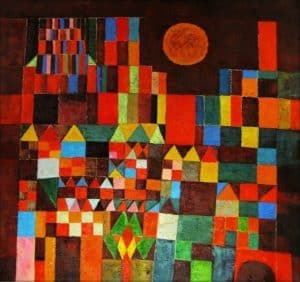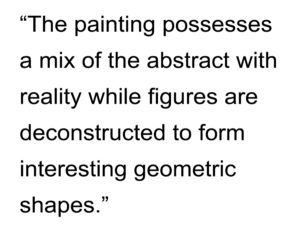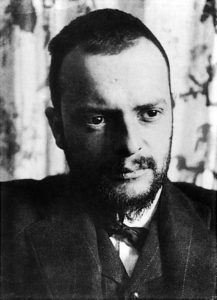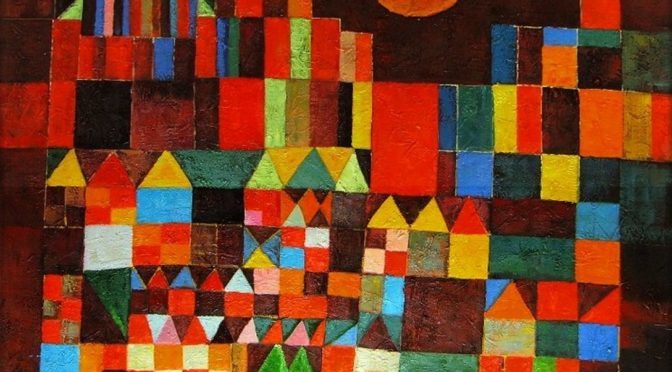
Vertical Geometries | The City in Art
by Dr. Mark David Major, AICP, CNU-A
Today’s issue of The City in Art returns to another innovative painting by the Swiss artist Paul Klee. The striking image Klee creates in Castle and Sun (1928) uses different geometric shapes and various shades of color, similar to the previously seen Klee’s Highways and Byways. The lone sun shines in the ingeniously designed sky with strong lines and the structure of the geometric shapes defining the castle/city. In addition, various rectangular sizes add depth to the abstract image. The complex and contrasting use of colors by Klee in this painting – in combination with the varying sizes of shapes – provides a subtle illusion of depth, independently of any proper perspective in gross terms otherwise lacking in the two-dimensional plane of the canvas. Klee executes the cubism technique of this painting in his patented style. The painting possesses a mix of the abstract with reality while figures are deconstructed to form interesting geometric shapes.  The clay colored background gives a clearer sense of how the shapes seem to form a city skyline of intense color and light. Klee uses pops of yellow to bring the eye in and break up the browns everywhere else. This oil on canvas painting has a complex array of triangular figures to provide an imaginary metropolis of shapes. The touch of realism, angles, and its use of color creates a city of geometric shapes. Paul Klee’s imaginary works continue to inspire and intrigue (Source: Totally History). Klee’s Castle and Sun, in particular, is regularly used by teachers for early education in artistic technique. At that age, school children (and perhaps their teachers) are unaware of the subtly complicated and innovative beauty of this painting by Klee.
The clay colored background gives a clearer sense of how the shapes seem to form a city skyline of intense color and light. Klee uses pops of yellow to bring the eye in and break up the browns everywhere else. This oil on canvas painting has a complex array of triangular figures to provide an imaginary metropolis of shapes. The touch of realism, angles, and its use of color creates a city of geometric shapes. Paul Klee’s imaginary works continue to inspire and intrigue (Source: Totally History). Klee’s Castle and Sun, in particular, is regularly used by teachers for early education in artistic technique. At that age, school children (and perhaps their teachers) are unaware of the subtly complicated and innovative beauty of this painting by Klee.
 About Paul Klee
About Paul Klee
Paul Klee (1879–1940) was born near Bern, Switzerland. He studied drawing and painting in Munich for three years beginning in 1898. By 1911, he was involved with the German Expressionist group Der Blaue Reiter (The Blue Rider), founded by Wassily Kandinsky and Franz Marc. In 1914, Klee visited Tunisia. The experience was the turning point. The limpid light of North Africa awakened his sense of color. Klee gradually detached color from physical description and used it independently, giving him the final push toward abstraction. In 1920, Walter Gropius invited Klee to join the faculty of the Bauhaus. Nearly half of Klee’s work was produced during the ten years he taught at the Bauhaus. From 1931-1933, Klee taught at the Academy of Fine Arts in Düsseldorf. When the National Socialists declared his art “degenerate”, he returned to his native Bern. Klee suffered from a wasting disease, scleroderma, towards the end of his life, enduring the pain until his death in Muralto, Locarno, Switzerland, on June 29, 1940 (Source: Metropolitan Museum of Art/Wikipedia).
Visit the Artsy.net Paul Klee page here.
The City in Art is a series by The Outlaw Urbanist. The purpose is to present and discuss artistic depictions of the city that can help us, as professionals, learn to better see the city in ways that are invisible to others. Before the 20th century, most artistic representations of the city broadly fell into, more or less, three categories: literalism, pastoral romanticism, and impressionism, or some variation thereof. Generally, these artistic representations of the city lack a certain amount of substantive interest for the modern world. The City in Art series places particular emphasis on art and photography from the dawn of the 20th century to the present day.

